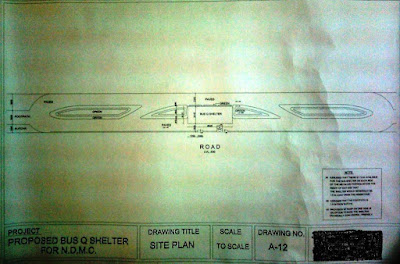In the Site Plan, you see how I have tried to guide the pedestrian while still a distance away from the Bus Q Shelter, to select his lane, ( :-) ) decide whether he has to enter the Bus Stand or not. If he/she needs to enter the Bus Stand then he/she will move towards the front. If not, he/she will move towards the rear. ‘Select from the diversion’. The pedestrian not intending to enter the shelter walks in one direction, the passenger waiting in the shelter walks in the perpendicular direction to that. So to prevent collisions between the two, I nudged the pavement walker towards the rear, and I had reminded myself initially while beginning the design that this is NDMC area, they have broad pavements. There can be space at the back. So the front is clear. He is not supposed to walk from towards the front. So people walk past from the rear. And if by error the city walker gets into the front lane then he/she can always move towards the rear by moving into and through the gap provided somewhere along the middle. Refer Site Plan Drawing. In fact I wanted to add another passage for the incidental rear lane strayer to allow himself/herself to come into the front lane too, but I don’t know why I thought that that may be an overkill. I restrained myself. But that stray rear entry wallah can still get towards the front by the same passage, only that he/she needs to go a little backward, as per this Design. That can be reworked though. In fact the reason of not going for a similar detour from the rear pavement was of possible ‘collision’. Then I thought that it was silly of me to think of collision, then I thought that perhaps it was not that silly to think of collision. Anyway, ‘possible collision’ between pedestrians (!) in the middle if they are changing lanes .. won. So there is that change lane provision in that direction that you see in the Drawing. In hindsight, I feel that I should have rather incorporated it - a similar arrangement in place for the accidental rear lane entry wallah. It is absolutely another matter that that may have been rejected, maybe outright. I mean both these ‘diversions’ for the “Holy Bus Stand” (ooh!) might have been scrapped. I don’t know. In fact this Site Plan was an “extra” from my side. It was not asked for. I prepared it from my own side, because my design asked for it. I exceeded the brief. I am proud of it. हम जब डिज़ाइन करते हैं तो हम कुएं के अंदर नहीं होते | हमारा व्यू वर्ल्डवाइड होता है | Our view is worldwide. We zoom in, we zoom out. वी ज़ूम इन, वी ज़ूम आउट | हम बहुत बड़ा दिल और बेहद ख़ास रवैया रखते हैं | आप कह सकते हैं की हम बड़े वो हैं ! On the serious side, I thought that this Design cannot exist in isolation. It has to take into account the surrounds – the entry from the side, front etc. It’s logic, isn’t it? Was I the first one ever in India to think like that (Site Plan must accompany the Bus Stand Plan) vis-a-vis the Bus Q Shelter Design? ;-) Unlikely perhaps? .. but I don’t know.
The Part Site Plan is showing a portion of the Site Plan for better grasp, understanding. And you will notice now that there is actually a distance between the Bus Q Shelter and the metalled portion or the carriageway as mentioned in the last post. This Shelter is not just after the kerb and does not start immediately from the road. And there is also provision from the road to make entry into the Bus Stand. We can’t discount that. People will enter from the road. Steps have been provided towards the left and right of the front of this Bus Stand (kerb) at the places one of which is directly in front of the gap between the Balcony Railing and the Left Railing and the other one is “not” directly in front of the gap between the Balcony Railing and the Right Railing but abutting it. The Ramp for the physically challenged comes directly in front there. Refer the earlier Post and the Plan. So of course there is provision of a ramp for the physically challenged. And thus this is physically challenged friendly. Ramp Slope was worked out.
Site Plan mentions the levels. The topography of the land at that place in Urbania may or not be flexible always but/and still the levels are there nevertheless. Some things are presumed. The Pavement is 300MM above the carriageway finished carpeted surface. The Ramp Slope is not 1:10, it is steeper, but not much. I don’t exactly recall the metrics of the same but the figures and the reason must be documented somewhere with me (not locatable at the moment). It is not trivia I know but not locatable. So if you are walking from towards the front of the Bus Stand then you may have to step a little down into the Ramp (perpendicular to the direction of the Ramp) and then take a step in the Ramp and then climb up back again. Slight drawback. And yes a further slight drawback is that you will step onto a slightly sloping surface (perpendicular to your movement) and not a level surface. This is trivia?, is it? Actually, when I design then these things come to the mind. And then I try to account for that. But then this is only a slight drawback that we wil have to live with. It is not much. But then again this can be further worked out.






